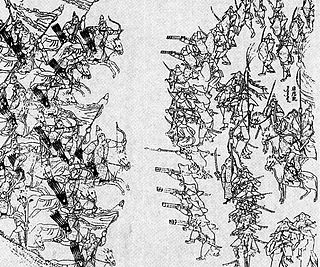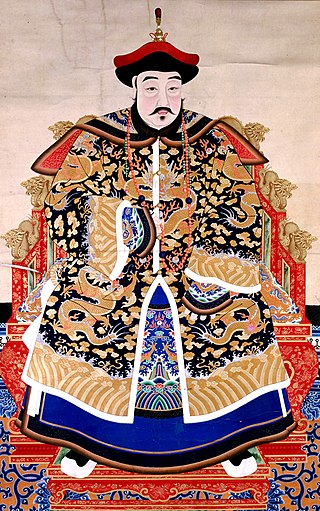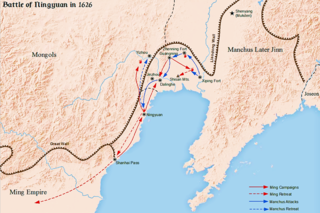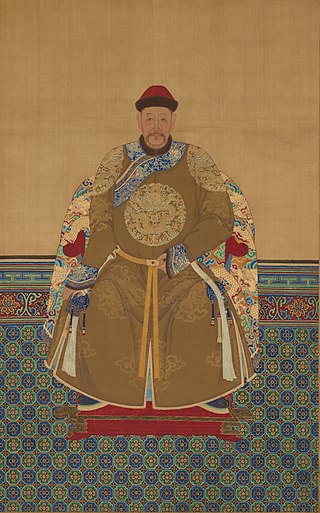
Hong Taiji, also rendered as Huang Taiji and sometimes referred to as Abahai in Western literature, also known by his temple name as the Emperor Taizong of Qing, was the second khan of the Later Jin dynasty and the founding emperor of the Qing dynasty. He was responsible for consolidating the empire that his father Nurhaci had founded and laid the groundwork for the conquest of the Ming dynasty, although he died before this was accomplished. He was also responsible for changing the name of the Jurchen ethnicity to "Manchu" in 1635, and changing the name of his dynasty from "Great Jin" to "Great Qing" in 1636. The Qing dynasty lasted until 1912.

The Battle of Sarhū refers to a series of battles between the Later Jin dynasty and the Ming dynasty and their Joseon allies in the winter of 1619. The battle is notable for the heavy use of cavalry by the Later Jin in defeating Ming and Joseon forces equipped with hand cannons, cannons, and matchlocks.

Dodo, formally known as Prince Yu, was a Manchu prince and military general of the early Qing dynasty.
The Seven Grievances was a manifesto announced by Nurhaci, khan of the Later Jin, on the thirteenth day of the fourth lunar month in the third year of the Tianming era of his reign; 7 May 1618. It effectively declared war against the Ming dynasty.
Hūlun was a powerful alliance of Jurchen tribes in the late 16th century, based primarily in modern Jilin province of China.

The Battle of Ningyuan was a battle between the Ming dynasty and the Later Jin dynasty in 1626. The Later Jin had been waging war on the Ming for several years, and their leader Nurhaci had deemed Ningyuan to be a suitable target for his attack, in part due to advice from a Ming defector, Li Yongfang. Later Jin failed to take the city and Nurhaci was wounded in the assault, dying eight months later. The Ming emerged victorious, marking a temporary resurgence of the Ming army after an eight-year-long series of defeats.

Nara is a clan name shared by a number of royal Manchu clans, sometimes also transliterated as Nalan or Nalland. The four tribes of the Hūlun confederation (扈倫四部) – Hada, Ula, Hoifa and Yehe – were all ruled by clans bearing this name.

Daišan was an influential Manchu prince and statesman of the Qing dynasty.
The Haixi Jurchens were a grouping of the Jurchens as identified by the Chinese of the Ming dynasty. They inhabited an area that consists of parts of modern-day Jilin, Heilongjiang, Liaoning and Inner Mongolia in China.

Cuyen was a Manchu prince and eldest son of the Later Jin ruler Nurhaci, the early patriarch of the Qing dynasty. An accomplished warrior, Cuyen was instrumental in the consolidation of Nurhaci's authority among rival Jurchen clans. He also served as the primary civil administrator for intermittent periods in the regime founded by Nurhaci. However, he eventually lost favour with his father because he tried to cast sorcery spells against other princes. He was placed in solitary confinement and died in captivity a few years later.
Jirgalang or Jirhalang was a Manchu noble, regent, and political and military leader of the early Qing dynasty. Born in the Aisin Gioro clan, he was the sixth son of Šurhaci, a younger brother of Nurhaci, the founder of the Qing dynasty. From 1638 to 1643, he took part in many military campaigns that helped destroy the Ming dynasty. After the death of Huangtaiji in September 1643, Jirgalang became one of the young Shunzhi Emperor's two co-regents, but he soon yielded most political power to co-regent Dorgon in October 1644. Dorgon eventually purged him of his regent title in 1647. After Dorgon died in 1650, Jirgalang led an effort to clean the government of Dorgon's supporters. Jirgalang was one of ten "princes of the first rank" (和碩親王) whose descendants were made "iron-cap" princes (鐵帽子王), who had the right to transmit their princely titles to their direct male descendants perpetually.
Baindari (?-1607) was a Jurchen beile (chieftain) of the Hoifa tribal confederation.

Nurhaci, also known by his temple name as the Emperor Taizu of Qing, was a Jurchen chieftain who rose to prominence in the late 16th century in Manchuria. A member of the House of Aisin-Gioro, he reigned as the founding khan of the Later Jin dynasty of China from 1616 to 1626.
Bujantai was a Jurchen beile (chieftain) of the Ula tribal confederation.
Gintaisi, known as Jintaishi or Jintaiji in Chinese, was a Jurchen beile (chieftain) of the Yehe tribal confederation.
Amin was a Manchu noble and an important military and political leader in the early years of the Qing dynasty.
Anfiyanggū, , was a Manchu official and one of the earliest companions of Nurhaci.

The Later Jin, officially known as Jin or the Great Jin, was a Jurchen-led royal dynasty of China in Manchuria and the precursor to the Qing dynasty. Established in 1616 by the Jianzhou Jurchen chieftain Nurhaci upon his reunification of the Jurchen tribes, its name was derived from the earlier Jin dynasty founded by the Wanyan clan which had ruled northern China in the 12th and 13th centuries.

Manggūltai was a Manchu noble and an important military and political leader in the early years of the Qing dynasty. He helped Hong Taiji consolidate his power by handing over his Plain Blue Banner to Taiji's. He died when he was 45 to 46 years old in 1633.

The Jurchen unification were a series of events in the late 16th and early 17th centuries that led to the unification of the Jurchen tribes under Nurhaci, a Jianzhou Jurchen leader who had an antagonistic relationship with the Ming dynasty due to their involvement in events early on in his life that led to the death of his father and grandfather. From 1583 to the early 1600s, Nurhaci led a series of military and influence campaigns that led to the unification of the majority of the Jurchen tribes. In 1616, Nurhaci established the Later Jin dynasty and ruled as its founding khan.










